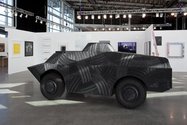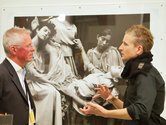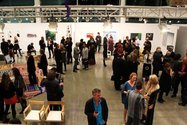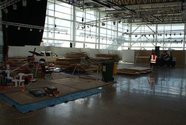Mark Amery – 10 August, 2011
Add-on aspects of the Fair like the Chartwell giveaway, a Lauren Lysaght community project and, outside, the yellow snaking boxes of Richard Maloy courtesy of SCAPE provided a welcome new public edge to the fair. Partnerships like this have the potential to make the fair the snapshot survey it proclaims to be. Temporal work speaks to elements that are intrinsic to the fair experience - people, space and time. They provide us with an antidote to the glut of objects.
Auckland Art Fair
4 August - 7 August 2011
Reviewing an art fair is a very different business to reviewing an exhibition. Yet the success of this year’s event deserves recording, and at least a modicum of critical attention.
Fairs don’t pretend to be a strong place for the good, sustained look and feel out of an artwork - something a gallery so carefully provides. In fact they encourage quite the opposite: something that can be alarming on first encounter, and new buyers need to bear in mind.
You are constantly distracted within the salon hang by what is next in your line of vision, and who just walked around the corner. (“Who is Billy Apple talking to?” “What a nice pink coat Emma Bugden is wearing” “Gosh Robert Leonard is looking good”). Even outside the opening vernissage this is principally a social experience, with the number of artists in attendance testify to the relaxed air that seemed to waft on a sea breeze through the events centre.
The undoubted star of this year’s event was its setting. The impressive new events centre, the super-yachts and fishing boats, the gift to Auckland of its waterfront with the opening of the Wynyard Quarter (complete with some impressive public art works) and some beautiful mild maritime weather. These were the prize exhibits. Wellingtonians had to swallow some pride - supersized Auckland has caught up and is roaring ahead.
A great party, an entertaining circus, a busy shopping mall, a country fair, all of these things the Auckland Art Fair may be. But an event that provides, as the art fair organisers tell us, “a snapshot of what’s current in contemporary Trans-Tasman art” - most definitely, not yet.
To further get the obvious out of the way: a quick whizz around some 41 New Zealand and Australian dealers (my calculation that 10 minutes with each would mean just under seven hours of viewing) misses out a huge amount of what is happening in contemporary art. Video comes close to being square box furniture to sit on and, as the cramped sculpture court at this years fair so patently showed, sculpture looks dead without space or environment (its centerpiece, the carved Brett Graham rendition of a Russian military scout car, from last years’ Sydney Biennale, looked lumpen and lacked for me the immediate layered punch of his stealth bomber). Much core contemporary art practice is installation and performance based and, however much dealers fiddle with their hangs, it’s not here.
Nor is it easy to critique the success of the various dealers’ hangs given the principle barometer of their success should be making sales, here or later. I struggled to engage with the crowded hangs of many stalls, but then they maybe just what the throngs of local apartment owners and office workers, living and working within walking distance, like. At the other end of the spectrum a number of dealers have taken Paul Nache Gallery’s 2009 lead and focused on one artist in cramped installation per day. I particularly liked Oedipus Rex’s hang of a large energetic Glen Wolfgramm work, cutting the air like sharpened helicopter rotor blades, yet its frenetic energy really wasn’t what I needed amongst this buzz.
The Paul Nache gallery meanwhile was trying to stay ahead of the pack with a Rob McLeod installation for the entire show. This could be called the art fair Trojan Horse strategy. It had the telling title ‘Proud to Commit Commercial Suicide’. The busyness of Nache’s friendly smile and his ipad (this year’s dealer gadget du jour, ideal for showing the artists’ work who are not on the walls), plus McLeod’s presence hopefully ensured he was committing anything but.
McLeod’s installation was a wacky, playful and constantly changing gaggle of gangly, gangrenous human figures. It was the art equivalent of a Haunted House at a fun fair, and provided a neat expressionistic portrait of the society around the event to boot.
Yet for all the compromises the art fair environment enforces, there were some dealers who really got the balance right. For me they were in the main those who gave you a breather, with a quieter more elegant form of curation. They provided refuges from the many stalls screeching at you colourfully to pay attention (the big sets of Karl Maughan and Reuben Paterson at Gow Langsford for example).
Top marks then to Robert Heald who presented work that quietly absorbs or measures time: the shoelace rulers and delicately incised and painted industrial materials of Patrick Lundberg, and the intimate drawings of John Ward Knox (cleverly the central image was of a sailing boat in full flight).
A respite from the bleeping of our handheld devices and urban encounters, this is what also made Dunedin’s Brett McDowell Gallery such a joy. McDowell again showed the terrific gouache and pencil works of Kushana Bush, but charged them with seventies drawings by Jeffrey Harris, nineteenth century etchings by James Ensor and more recent ones by Paula Rego.
It’s worth noting very few attending will have actually visited the galleries of Nache, Heald and McDowell, nor seen the recent work of these artists - and their displays seemed all the more carefully considered for it.
Dealers who focus keenly on one area actually work well in an art fair context. They can provide a truer snapshot - even if its fish tank sized - from already working to represent the best of their media from across Australasia. In this regard the absence of McNamara Gallery and Solander Works on Paper, who represent fine art photography and works on paper respectively, is noted. A shame also given the comparative affordability of what they represent. I did however very much enjoy Auckland based Masterworks stand, who illustrated just how strong the applied arts are currently across the country.
Special mention must also go to rather smart giveaway video work ‘Feedback’ by Clinton Watkins, organized by Starkwhite and the Chartwell Trust. This was available for download during the duration of the fair. Watkins’ slowly spinning blank CD film has been beautifully made, conceptually and visually, for my iTunes display. It’s made me rethink my aversion to the presentation of art on computer screen and the collection of video art - a rather effective intervention into the market.
Add-on aspects of the Fair like the Chartwell giveaway, a Lauren Lysaght community project and, outside, the yellow snaking boxes of Richard Maloy courtesy of SCAPE (which would have been far more effective as a live event inside) provided a welcome new public edge to the fair. Partnerships with organisations like this are to be encouraged. They need to be furthered and better integrated into the fabric of the fair itself. They even have the potential to make the fair the snapshot survey it proclaims to be. Temporal work speaks to elements that are intrinsic to the fair experience - people, space and time. They provide us with an antidote to the glut of objects.
What about a darkened space for a curated programme of video work with comfy seating and coffee (a respite from all the colour and waterfront glare)? Time and space did a disservice to all the video on display in the stalls.
What about also a performance series that plays with the shop-floor dynamics of the fair, and its exciting surroundings? (The hit of the vernissage for me, in its drunken dying moments, were the fleet of large commercial fishing boats unloading their catches right before us outside the impressive glass doors). There is the potential here also for a reflection of the strength of contemporary Pacific Island performance work. For all the dealers’ weight on displays of their Maori and Pacific Island artists, this fair did not feel like it was taking place in the capital of the Pacific. So why not balance the shoptalk with art that is of this event’s place and space; work that speaks to the unique, and rather special, social and political experience that the Auckland Art fair provides? Provide a swing bridge between the public and private.
If the fair can hold onto its spectacular setting its future looks spectacularly bright.
Mark Amery
Recent Comments
John Hurrell
Fair comment Peter. Note however for the Art Fair review illustrations, only one work is identified. A sculpture.
peter madden
their were 4 artists on show at the Robert Heald stand its just one of the artists presented sculpture . ...
Hannah James
Judy certainly has a point - there was a real lack of women artists work at the Fair. Worryingly this ...







 Two Rooms presents a program of residencies and projects
Two Rooms presents a program of residencies and projects Advertising in this column
Advertising in this column



This Discussion has 17 comments.
Comment
John Hurrell, 11:28 a.m. 10 August, 2011 #
Well Mark, you are a Wellingtonian - and me, I'm a wannabe Aucklander - and so in that context I think of the dealer displays I saw during my one visit (on the Sunday) that Michael Lett took the prize with his Campbell Patterson presentation. I liked the cheekiness of the cornflake (kornie?) paintings especially - alluding to performance and also aboriginality. Gutsy stuff, like the Eve Armstrong display he did a few years ago.
And I was puzzled why (of the Auckland galleries) Gow Langsford didn't show off the intelligence of their star painters, Simon Ingram and James Cousins. Talk about wasting an opportunity when the place is chocka with visitors!
Mark Amery, 1:03 p.m. 10 August, 2011 #
Thanks John,
Two caveats to my review, one with regards to your comments.
Firstly, the time nature of the event (which I mention) means that even though I had more time there than you that doesn't mean I gave all stands as much attention as others. Case in point Michael Lett. Thus I give 'top marks' to Robert Heald, but that is not meant to imply others were not equally deserving of such attention (this is not so dissimilar to reviewing an exhibition where you don't go out of your way to mention every great work). I'd really welcome hearing from others as to aspects of the fair they found strong.
Secondly, I should have acknowledged a perceived conflict of interest. I wrote an essay for the Art fair catalogue, which itself was not uncritical. In a sense this review forms a 'part two' to that commentary.
So, again more debate and discussion from others on their art fair experience would help.
Cynthia Bongolaire, 2:59 p.m. 10 August, 2011 #
For me Robert Heald had it spot on. 3 artists, select works which were all distinct yet complemented each other and didn't clutter the space. A properly curated stand.
John Hurrell, 7:18 p.m. 10 August, 2011 #
I agree Cynthia that the Heald presentation was impeccable with his arrangement of Lundberg, Bryant and Ward Knox items. They are all very fine artists, but on my day at the Fair I was more fascinated by the particularly radical use of materials shown by Patterson in his paintings of towelling and sultana bran. (I thought they were cornflakes).
http://www.michaellett.com/artist/?artist=Campbell+Patterson&info=work&show=Campbell+Patterson%0D%0AAuckland+Art+Fair#
Judy Millar, 8:42 a.m. 12 August, 2011 #
gosh guys, was there the work of any women artists at the fair at all, I mean I just don't see any mention...
John Hurrell, 9:28 a.m. 12 August, 2011 #
Judy, I thought the conversation was about a frank appraisal of dealer presentation and the work displayed, not eighties tokenism.
Do you consider gender first when examining work, then to assess quality? I'd be surprised if you do.
Judy Millar, 9:45 a.m. 12 August, 2011 #
no of course I don't, it just occurred to me that part of that frank appraisal could have noted the lack (or not) of work from women artists on the preferred stands, and I couldn't help but notice that of the two Scape projects presented Ruth Watson's was not mentioned
John Hurrell, 10:07 a.m. 12 August, 2011 #
I see Mark does mention Kushana Bush, Paula Rego and Lauren Lysaght. With Ruth's work you'd have to be visiting the Wynyard Quarter at night or evening to see her projections.
Readers might be interested in Anthony Byrt's article on the fair for Artforum: http://artforum.com/diary/#entry28726
Owen Pratt, 2:13 p.m. 12 August, 2011 #
Wow, did you link to the Artforum article to show how ethical EyeContact actually is, John?
The image of Rohan Whellan with his two 'friends' who are both wearing Karl Maugham styles dresses and using Karl's painting as a backdrop is a low point of art marketing for me. Wtf were G - L thinking? Were people lining up to have these pictures taken like some kind of Santa's grotto at the mall? Very tacky .
As for (the anonymous) dealer quote (fu*king heaps) what do you think, drunk, stupid or both?
John Hurrell, 2:34 p.m. 12 August, 2011 #
Is EC ethical because we don't corrupt our readers you mean? Well Artforum is just revealing the tricks dealers use to upstage each other. No reason to give Knight Landesman a set of horns, cape and trident.
Mark Amery, 6:26 p.m. 15 August, 2011 #
I think Judy has a point - and the point is that women artists didn't have as strong a presence at the fair in terms of the big displays. I didn't see the Ruth Watson.
John Hurrell, 6:58 p.m. 15 August, 2011 #
So what would be the significance of that? That women are (for example) highly represented at the tertiary institutions as teachers and as the student base but not as producers of merchandise for the market? If we looked at shows in dealer galleries overall, does the fair correlate?
Mark Amery, 7:53 p.m. 15 August, 2011 #
The significance for me John (apart from strong professional artists getting good representation) is that women offer an approach to artmaking which has its own arguable distinctions to men - we can say the same things of age and race. Generalisations for sure, but they are why diversity and representation are important to note (if not able to be curated at a fair). I'm thinking of the large works of Millar and Morison say vs those of Maughan and Wolfgramm. In the sculpture court the point seemed made by the prevalence of big male work (yes some of it phallic...) next to a small Sarah Lucas at the Two Rooms stall.
John Hurrell, 9:22 p.m. 15 August, 2011 #
I think I'm pretty suspicious of anything that smacks of essentialism, especially as many groups, of whatever age, gender or race, are all happily appropriating each other now. The confusion makes things more interesting. What you see is often not what you are getting.
But this phenomenon is really irrelevant because art fairs are there to help dealers make money, not demonstrate fanciful philosophical treatises, and I would have thought there was lots of money to made by selling art by women. Only idiots would only buy the work of men, and most buyers I assume are not idiots.
Hannah James, 5:21 p.m. 16 August, 2011 #
Judy certainly has a point - there was a real lack of women artists work at the Fair. Worryingly this seems to be the case in many so called 'top' dealer galleries yet some of the best artwork in NZ has been/is being made by women.
One of the stand out works for me at the fair was Irene Ferguson's life-size portrait of Flying Nun Records founder Roger Shepherd at the Suite gallery stand.
http://www.suite.co.nz/artists/irene_ferguson/roger_shepherd
peter madden, 10:23 a.m. 20 August, 2011 #
their were 4 artists on show at the Robert Heald stand its just one of the artists presented sculpture . its not surprising everybody here missed it as most of the discusion swirling around the art fair and this discusion is privileging wall practice namley painting.
John Hurrell, 2:34 p.m. 20 August, 2011 #
Fair comment Peter. Note however for the Art Fair review illustrations, only one work is identified. A sculpture.
Participate
Register to Participate.
Sign in
Sign in to an existing account.